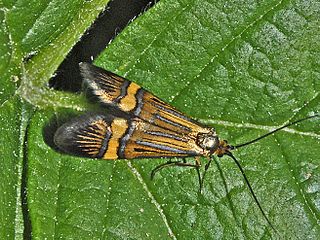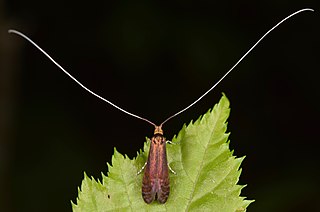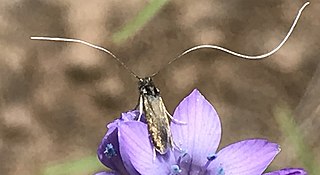
The Adelidae or fairy longhorn moths are a family of monotrysian moths in the lepidopteran infraorder Heteroneura. The family was first described by Charles Théophile Bruand d'Uzelle in 1851. Most species have at least partially metallic, patterned coloration and are diurnal, sometimes swarming around the tips of branches with an undulating flight. Others are crepuscular and have a drab coloration. Fairy longhorn moths have a wingspan of 4–28 millimeters, and males often have especially long antennae, 1–3 times as long as the forewing.

The longhorn moth or yellow-barred long-horn is a diurnal lepidopteran from the moths family Adelidae.

The green longhorn is a lepidopteran from the moth family Adelidae, the fairy longhorn moths.
The 1969 Texas Longhorns football team represented the University of Texas at Austin in the 1969 NCAA University Division football season. The Longhorns won all eleven games to win their second consensus national championship; the first was six seasons earlier in 1963.

Adela australis is a moth of the family Adelidae or fairy longhorn moths.

Adela is a genus of the fairy longhorn moth family (Adelidae). Among these, it belongs to subfamily Adelinae.

Nemophora bellela is a moth of the Adelidae family. It is the only circumpolar species of the Nemophora, and the only representative of the genus in North America, where it is found from Quebec across Canada north of the plains to the mountains of British Columbia and Alaska.
Coelopoeta phaceliae is a moth in the superfamily Gelechioidea. It is found in the US state of California.

Adela caeruleella, the southern longhorn moth, is a moth of the family Adelidae or fairy longhorn moths. It was described by Francis Walker in 1863. It is found in North America, including Alabama, Arkansas, Florida, Illinois, Kentucky, Louisiana, Maryland, Mississippi, North Carolina, Ohio, Oklahoma, Pennsylvania, South Carolina, Tennessee, Texas, Virginia and West Virginia.
Adela eldorada is a moth of the family Adelidae or fairy longhorn moths. It was described by Powell in 1969. It is found from Washington to California.

Adela flammeusella is a moth of the family Adelidae or fairy longhorn moths. It was described by Vactor Tousey Chambers in 1876. It is found in the United States from southern Washington south to the foothills and interior valleys of most of cismontane California.

Adela punctiferella is a moth of the family Adelidae or fairy longhorn moths. It was described by Walsingham in 1870. It is found in the semi-arid parts of California and southern Nevada.

Adela purpurea is a moth of the family Adelidae or fairy longhorn moths. It was described by Francis Walker in 1863. It is widespread in boreal North America, from the Yukon through the southern provinces of Canada to Quebec and further south to northern New Jersey.

Adela ridingsella, Ridings' fairy moth, is a moth of the Adelidae family or fairy longhorn moths. It was described by James Brackenridge Clemens in 1864. It is widespread in eastern North America, from Nova Scotia, Ontario, Quebec and Maine to Pennsylvania and the mountains of North Carolina. Adults are on wing from June to July.

Adela septentrionella is a moth of the family Adelidae or fairy longhorn moths. It was described by Walsingham in 1880. It is widespread from southern British Columbia and north-western Idaho to the Transverse Range in southern California.

Adela singulella is a moth of the family Adelidae or fairy longhorn moths. It was described by Walsingham in 1880. It is found in California.

Adela thorpella is a moth of the Adelidae family or fairy longhorn moths. It was described by Powell in 1969. It is found in California.
Adela praepilosa is a moth belonging to the family Adelidae, the fairy longhorn moths. Its Japanese name is kebuka higenaga (ケブカヒゲナガ).

A MONA number, or Hodges number after Ronald W. Hodges, is part of a numbering system for North American moths found north of Mexico in the Continental United States and Canada, as well as the island of Greenland. Introduced in 1983 by Hodges through the publication of Check List of the Lepidoptera of America North of Mexico, the system began an ongoing numeration process in order to compile a list of the over 12,000 moths of North America north of Mexico. The system numbers moths within the same family close together for identification purposes. For example, the species Epimartyria auricrinella begins the numbering system at 0001 while Epimartyria pardella is numbered 0002.
















